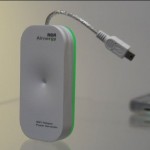(I have a draft post on “teaching to the test” rattling around somewhere, hence the title of this one.)
 The gadget shown here was displayed at the recent Consumer Electronics Show. Cnet reported:
The gadget shown here was displayed at the recent Consumer Electronics Show. Cnet reported:
The device, called the Airnergy, uses an antenna and circuitry to harvest the energy and an internal battery to store the electrical charge. A company representative told OhGizmo that they were able to charge a BlackBerry from 30 percent to full charge in about 90 minutes using the ambient Wi-Fi signal at CES, although the charge time varies depending on how close the battery is to the original signal.
Now, this doesn’t really pass the sniff test, but, after all, it’s RCA, and they “demonstrated” it, so what the hell? The point of this post is that a judgement like this can be informed by a little back-of-the-envelope calculating, and that this is an example of the kind of skill that I’ll argue elsewhere, eventually, ought to be possessed by any graduate of a high school physics class.
We need some basic facts first. Wikipedia tells us that wifi base stations are limited by the FCC to 4 watts output. My cellphone battery is labeled: 3.7VDC 1150mAH. Assuming 100% charging efficiency, that’s 4.255 watt-hours required for a full charge. I’ll guess from the picture that the receiving antenna is 100 cm2 and that we put it a meter from the transmitter. How much power does the charger “see”?
We know (or can easily look up) that the surface of sphere is 4πr2, so the surface of a sphere with a radius of a meter is about 12m2, or 120,000cm2. Our 100cm2 antenna represents 100/120,000 or 1/1200 of the sphere, which is 4mW.
So at a distance of a meter, we’re looking at 1000 hours to fully charge my Palm Centro battery.
Notice that we’ve erred on the side of generosity to the RCA device. Neither the antenna nor the charger nor the battery charging system is going to be 100% efficient, and the device itself looks to be smaller than 10x10cm. And we’re not going to be within a meter of the wifi box at our local Starbucks.
It’s apparent that, to the extent that the device actually works, it does so only by being in very close proximity to the wifi transmitter.
Now, I suppose there’s a test question here that we could (and should) teach to. Quote the Cnet article and ask, “Is this device practical? Justify your conclusion.” Trouble is, that question requires the kind of answer that’s impossible to grade automatically, and in general, it seems to me that the same thing is true whenever we test practical skills—knowing how, rather than knowing that.
More Real Soon Now.
Addendum: If I were grading the answers to that question, here are some of the elements I’d be looking for.
- We’re interested in how much power is available from the wifi transmitter, and how much energy (power times time) is required.
- We’re interested in the area of the surface of a sphere, and the notion that the power available to the device drops with the square of the distance from the transmitter.
- Assumptions ought to be conservative. If the answer claims that the device is practical, then it should make conservative assumptions about efficiency and size; if not, then (as above) the conservative assumptions go the other way, giving the device the benefit of the doubt.
- If the answer concludes that the device is not practical, it would be a plus to suggest what RCA is up to, and how it might have been “demonstrated”.